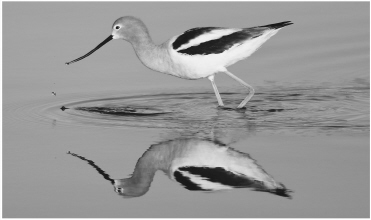
focus  American Avocet
American Avocet
Avocets are remarkable shorebirds in many ways. They are striking and conspicuous in contrasting black-and-white plumage, legs like sky-blue stilts, and heads the colour of soft rust. But their truly distinctive feature is a long, up-curved bill. The shape of the bill fits exactly with their feeding technique—they wade through shallow water, sweeping their bills back and forth, searching for invertebrates such as brine shrimp. The recurved shape of the bill allows them to have more bill in the water at any one time, and therefore a better chance at finding a tasty morsel with each sweep. They make their homes on the ground near the shoreline, creating a nest of dried mud that they can build up if water levels should rise.
Avocets are birds of alkaline prairie sloughs and were considered casual breeding birds in British Columbia until 1987, when two pairs nested on Alki Lake. The population grew so that by 1997 nineteen pairs nested there. The number fluctuates from year to year depending on water levels in the local area as well as in the centre of the species’ range. The City of Kelowna plans to construct a separate shallow lake outside the landfill to mitigate the eventual loss of Alki Lake from landfill expansion—it will be interesting to see if the complex set of conditions needed to attract the avocets can be recreated in the new setting.